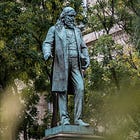"Competitive authoritarianism" and America's slide toward it
You can still vote. It just might not mean much.
Public Notice is supported by paid subscribers. Become one 👇
Last week, Trump announced that he wants to change the census so that it excludes undocumented immigrants. That’s unconstitutional. It’s also a way for Republicans to simply remove representation from populations that vote against them.
The change would be in line with Trump’s demand that red states engage in an orgy of mid-cycle gerrymandering aimed at allowing Republicans to increase the number of safe GOP seats and make it possible for them to hold onto the House despite their deeply unpopular policies. Trump and his MAGA toadies hate democracy and they have decided that elections are illegitimate — unless Republicans win.
Experts have argued that the United States is moving towards what they call “competitive authoritarianism.” Scholars Steve Levitsky and Lucan Way describe such systems as one that are not democratic but “feature arenas of contestation in which opposition forces can challenge, and even oust, authoritarian incumbents.”
Competitive authoritarianism is usually thought of as a new global development. However, you can also see competitive authoritarianism as a prevalent form of government throughout American history — one which we have only tentatively started to move away from in recent decades. Trump in that context is not an innovator, but an avatar of backlash.
The Orbán model
When experts talk about competitive authoritarianism, they are usually referring to countries like Hungary and Turkey. A leader is elected in a more or less democratic system — and then starts to work to break the democracy that put them in power.
For instance, Viktor Orbán, Hungary’s current fascistic leader, became prime minister (for the second time) back in 2010. Gábor Scheiring, a former member of Hungary’s Parliament, says Orbán subverted Hungary’s democracy by putting in place a “nationwide right-wing media network” and by “gerrymandering local districts.” Orbán put loyalists in the public prosecutor’s office, ensuring that the judicial system would go after his enemies rather than after government corruption. He also targeted universities.
Orbán has now been back in office 15 years, and while he has consolidated power, there is still resistance. His effort to outlaw the Pride parade in Budapest this year backfired, as tens of thousands of people took to the streets to support the LGBT community and express opposition to the regime. That was seen as a possible warning sign for Orbán in next year’s elections — though he’s also using the event as an excuse to target opposition figures who he accuses of helping to organize it.
As Scheiring notes, the parallels with Trumpism here are hard to miss.
Scheiring argues that Orbán succeeded in part because of the economic abandonment of rural areas. Whether or not this is an accurate description of Hungary’s slide into strongman rule, we know from numerous studies that support for Trump was not driven by economic anxiety. Instead, Trump capitalized on worries from white people, men, and economic elites who worried that they were in danger of losing status.
In short, Trump’s authoritarianism has resonated with people who find racism and other forms of bigotry congenial. This is not especially surprising since racism and authoritarianism have underpinned a form of competitive authoritarianism in the United States for basically the entirety of its existence.
American history
Leaders, voters, pundits, and educators all tend to present the history of the United States as a robust 250-year story of establishing and expanding democracy.
Initially, when the Constitution was first instituted, there were some groups — Black people, women, poor people, Native Americans — who were not able to vote and had no voice in government. But this was an oversight. In time the principles of equality and freedom inevitably demanded the extension of votes to all, leading, finally, to our venerable, just, and stable (pre-Trump) democracy.
This is obviously a hopeful way to look at things. But in the advent of Trump, it’s difficult not to consider less cheery narratives.
As one example, philosopher Charles W. Mills, in his seminal 1997 monograph “The Racial Contract,” argues that the antidemocratic aspects of the Constitution were not just incidental errors, inevitably corrected. Instead, Mills argues that in European nations and colonies, and certainly in the United States, “the polity was usually thought of in racial terms, as white ruled.” That is to say, in Mills’s view the Founding Fathers explicitly and deliberately conceived of democracy as applying only to white people, who were to rule as authoritarians over everyone else.
Osita Nwanevu, in his new book “The Right of the People,” makes a parallel argument. Looking carefully at the discussions at the Constitutional Convention, he points out that the white, male, wealthy Founders were terrified of broadening democracy, and created the Constitution expressly to stifle populist power and economic programs — to fight against what many at the time referred to as “excessive democracy” and “democratic licentiousness.”
As Mills and Nwanevu make clear, the United States was not initially — nor perhaps ever — an actual democracy. The Senate was not directly elected, but chosen by state legislators, which (Nwanevu notes) was intended to limit the voices of less wealthy and powerful people in government. Black people were systematically disenfranchised under slavery and then (after a brief flowering of freedom under Reconstruction) stifled again under Jim Crow.
The disenfranchisement was inextricable from a system of entrenched authoritarianism. By disenfranchising Black people through Jim Crow, the South ensured that Jim Crow could not be overturned, because only those who benefited from the system could vote.
Some people could vote, and elections were legitimately contested. But the system was constructed in such a way that authoritarian subjugation — especially of Black people — could not be meaningfully altered through electoral means.
Returning to our traditions
After decades of struggle and protest, the Civil Rights Movement finally pushed Lyndon Johnson to pass the Civil Rights Act of 1968 and break the hammerlock of Jim Crow. Black people gained voting rights and finally had a sustained voice in elections. The US became a democracy — or at least much closer to a democracy than it had been before.
But that democracy continued to be contested. The Republican Party enthusiastically took up the mantle of white supremacy and attempted for decades to turn the United States once again into an authoritarian state in which white people could compete with each other — and with no one else.
Wisconsin served as a laboratory. For a decade, the Republican Party in the state gerrymandered the electoral map so thoroughly that Republicans won legislative supermajorities even when the statewide vote was evenly split. People could vote; there was a contest. But Democratic voters — and especially Black Democratic voters — were deliberately kept from having a real voice in government.
Wisconsin’s Supreme Court has finally broken the gerrymander. But nationally, the Republican Supreme Court’s attack on the Voting Rights Act has paved the way toward Orbán-style competitive authoritarianism. Trump’s gerrymandering scheme would finish the journey.
It’s no accident that the seats targeted by the Texas redistricting plan include those held by some of the most visible, vocally anti-Trump Black Democrats in Congress, including Jasmine Crockett and Al Green. Trump’s goal is to destroy Black voting power and Black leadership. He intends to return to a government of white power in which Black people and their allies have their voices suppressed and little ability to contest elections or change their fate through the ballot.
There is no doubt that Trump and those around him look to Orbán as a model and inspiration — Trump wouldn’t keep praising his fellow strongman otherwise. But if competitive authoritarianism was completely foreign or new, it’s unlikely it would resonate so powerfully beyond Trump’s hardcore sycophants.
The reason so many American institutions — media, corporations, political parties, voters — have embraced Trump’s vision of disenfranchisement and authoritarianism is because it feels familiar, comfortable, even traditional. Authoritarianism has a long pedigree in the US. For many who still pine for white supremacy, patriarchy, and oligarchy, competitive authoritarianism resonates with their sense of how government should work and who it should work for.
That’s it for today
We’ll be back with more tomorrow. If you appreciate this edition, please do your part to keep Public Notice free by signing up for a paid subscription.
Thanks for reading.







Noah nailed it. This was very informative. It is a relief to finally see more writers using the term fascism. His focus on Hungary and Turkey offers a real-world current model to justify his assertions about Trumpist MAGAism.
As a psychologist, it is puzzling how so many Americans can embrace a candidate for president who made it clear when running that he was going to be a dictator on "Day-1." To most of us who voted for somebody else in 2024, the MAGA population seemed to be endorsing policies that would create self-inflicted harm to their own best interests - tariffs - for example. My best hypothesis is limited critical reasoning skill. Then, when noting that most MAGA voters live in rural areas, I began to wonder if there was a correlation there.
I grew up in a small German immigrant farming village west of Chicago. I managed to escape what I call Whiteflightburbia at age 13 by convincing my parents to send me to a Catholic prep school in Chicago's inner city. Unlike my pals back home, I was taught critical reasoning. I also observed that my classmates from the inner city already had a head start on critical reasoning - it was a necessary skill to function in urban life.
By college age, I had noted that most of my pals in the neighborhood back home did not reflect the critical reasoning my prep school pals did. At the time, I associated it with attending a better high school; not living in a sub-urban bubble. Today, I think I might have overlooked that critical reasoning skill in farm-county is not that essential. Life is rather routine and the town culture is quite homogeneous in contrast to big cities like Chicago where you always need to be alert to possible scams and threats. Maybe that is how MAGA mainly took hold in Red states, but not states with large urban populations.
Excellent Noah, and I agree. As you’ve so eloquently stated, we at least were always moving towards a country of inclusion, to fulfill our mandate as a democracy. Today, we’re sliding backwards, and worse, the Supreme Court has legalized corruption, and voter suppression.
And now they are taking up the last remnants of the Civil Rights Act right before the midterms, giving Trump and his minions another opportunity to win an election by suppressing voters rights.
Bottom line; they won’t kill the bill outright, but they’ll gut it to the point where it’s toothless, which could be enough to tip the scales once and for all, making us for all intents and purposes a competitive authoritarian state; if we aren’t already! IMHO…:)